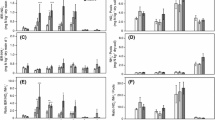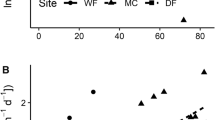Abstract
Invasive plants have variable effects on net nitrogen cycling, but how invasion alters gross N cycling is poorly understood. We examine how Bromus inermis (smooth brome) invasion affects gross N cycling rates and investigate potential mechanisms for the changes including relationships between smooth brome and ammonia-oxidizing bacteria (AOB) and archaea (AOA), plant community productivity, and litter quality. Gross nitrogen cycling rates, AOA and AOB population sizes, and plant community productivity were examined in native and invaded plots in smooth brome-invaded rough fescue grassland in central Saskatchewan, Canada. Despite no changes in inorganic nitrogen between invaded and native grassland soils, gross nitrogen mineralization rates and total soil nitrogen were higher in invaded soils. Invaded areas had greater plant productivity and litter production, which likely stimulated microbial activity and higher gross mineralization rates. Nitrification rates did not differ between invaded and native soils. Smooth brome had a weak positive effect on AOA in the B horizon but not in the A horizon, and AOB responded positively in both horizons. These results demonstrate that the full effects of plant invasion on soil N cycling may be masked in net N cycling rate measures.



Similar content being viewed by others
References
Accoe F, Boeckx P, Busschaert J, Hofman G, Van Cleemput O (2004) Gross N transformation rates and net N mineralisation rates related to the C and N contents of soil organic matter fractions in grassland soils of different age. Soil Biol Biochem 36:2075–2087
Agriculture and Agri-Food Canada (2010) Soils of Canada. Agriculture and Agri-Food Canada: Canadian Soil Information Service
Bais HP, Weir TL, Perry LG, Gilroy S, Vivanco JM (2006) The role of root exudates in rhizosphere interactions with plants and other organisms. Annu Rev Plant Biol 57:233–266
Banerjee S, Siciliano SD (2012) Factors driving potential ammonia oxidation in Canadian Arctic ecosystems: does spatial scale matter? Appl Environ Microbiol 78:346–353
Bedard-Haughn A, Matson AL, Pennock DJ (2006) Land use effects on gross nitrogen mineralization, nitrification, and N2O emissions in ephemeral wetlands. Soil Biol Biochem 38:3398–3406
Bedard-Haughn A, Comeau L-P, Sangster A (2013) Gross nitrogen mineralization in pulse-crop rotations on the Northern Great Plains. Nutr Cycl Agroecosyst 95:159–174
Belnap J, Phillips SL (2001) Soil biota in an ungrazed grassland: response to annual grass (Bromus tectorum) invasion. Ecol Appl 11:1261–1275
Booth MS, Stark JM, Rastetter E (2005) Controls on nitrogen cycling in terrestrial ecosystems: a synthetic analysis of literature data. Ecol Monogr 75:139–157
Bradford M, Strickland M, DeVore J, Maerz J (2012) Root carbon flow from an invasive plant to belowground foodwebs. Plant Soil 359:233–244
Bustin SA, Benes V, Garson JA, Hellemans J, Huggett J, Kubista M, Mueller R, Nolan T, Pfaffl MW, Shipley GL, Vandesompele J, Wittwer CT (2009) The MIQE guidelines: minimum information for publication of quantitative real-time PCR experiments. Clin Chem 55:611–622
Callaway RM, Aschehoug ET (2000) Invasive plants versus their new and old neighbors: a mechanism for exotic invasion. Science 290:521–523
Corbin JD, D’Antonio CM (2004) Effects of exotic species on soil nitrogen cycling: implications for restoration. Weed Technol 18:1464–1467
Cornelissen JHC (1996) An experimental comparison of leaf decomposition rates in a wide range of temperate plant species and types. J Ecol 84:573–582
Couteaux M-M, Bottner P, Berg B (1995) Litter decomposition, climate and liter quality. Trends Ecol Evol 10:63–66
Davidson EA, Hart SC, Shanks CA, Firestone MK (1991) Measuring gross nitrogen mineralization, and nitrification by 15 N isotopic pool dilution in intact soil cores. J Soil Sci 42:335–349
Di HJ, Cameron KC, Shen JP, Winefield CS, O’Callaghan M, Bowatte S, He JZ (2009) Nitrification driven by bacteria and not archaea in nitrogen-rich grassland soils. Nat Geosci 2:621–624
Di HJ, Cameron KC, Shen J-P, Winefield CS, O’Callaghan M, Bowatte S, He J-Z (2010) Ammonia-oxidizing bacteria and archaea grow under contrasting soil nitrogen conditions. FEMS Microbiol Ecol 72:386–394
Duda JJ, Freeman DC, Emlen JM, Belnap J, Kitchen SG, Zak JC, Sobek E, Tracy M, Montante J (2003) Differences in native soil ecology associated with invasion of the exotic annual chenopod, Halogeton glomeratus. Biol Fertil Soils 38:72–77
Ehrenfeld JG (2003) Effects of exotic plant invasions on soil nutrient cycling processes. Ecosystems 6:503–523
Ehrenfeld JG (2010) Ecosystem consequences of biological invasions. Annu Rev Ecol Evol Syst 41:59–80
Evans RD, Rimer R, Sperry L, Belnap J (2001) Exotic plant invasion alters nitrogen dynamics in an arid grassland. Ecol Appl 11:1301–1310
Eviner V (2004) Plant traits that influence ecosystem processes vary independently among species. Ecology 85:2215–2229
Facelli JM, Pickett STA (1991) Plant litter: its dynamics and effects on plant community structure. Bot Rev 57:1–32
Fink KA, Wilson SD (2011) Bromus inermis invasion of a native grassland: diversity and resource reduction. Botany 89:157–164
Grilz PL, Romo JT (1995) Management considerations for controlling smooth brome in fescue prairie. Nat Areas J 15:148–156
Groffman PM, Rice CW, Tiedje JM (1993) Denitrification in a tallgrass prairie landscape. Ecology 74:855–862
Hawkes CV, Wren IF, Herman DJ, Firestone MK (2005) Plant invasion alters nitrogen cycling by modifying the soil nitrifying community. Ecol Lett 8:975–976
Hodge A, Robinson D, Fitter A (2000) Are microorganisms more effective than plants at competing for nitrogen? Trends Plant Sci 5:304–308
Horz H-P, Barbrook A, Field CB, Bohannan BJM (2004) Ammonia-oxidizing bacteria respond to multifactorial global change. Proc Natl Acad Sci USA 101:15136–15141
Inderjit, van der Putten WH (2010) Impacts of soil microbial communities on exotic plant invasions. Trends Ecol Evol 25:512–519
Kaye JP, Hart SC (1997) Competition for nitrogen between plants and soil microorganisms. Trends Ecol Evol 12:139–143
Knops JMH, Bradley KL, Wedin DA (2002) Mechanisms of plant species impacts on ecosystem nitrogen cycling. Ecol Lett 5:454–466
Köchy M, Wilson SD (2001) Nitrogen deposition and forest expansion in the northern Great Plains. J Ecol 89:807–817
Kourtev PS, Ehrenfeld JG, Haggblom M (2002) Exotic plant species alter the microbial community structure and function in the soil. Ecology 83:3152–3166
Lamb EG (2008) Direct and indirect control of species richness and evenness by litter, resources, and biomass. Ecology 89:216–225
Lamb EG, Kennedy N, Siciliano SD (2011) Effects of plant species richness and evenness on soil microbial community diversity and function. Plant Soil 338:483–495
Laungani R, Knops J (2009) Species-driven changes in nitrogen cycling can provide a mechanism for plant invasions. Proc Natl Acad Sci USA 106:12400–12405
Leininger S, Urich T, Schloter M, Schwark L, Qi J, Nicol GW, Prosser JI, Schuster SC, Schleper C (2006) Archaea predominate among ammonia-oxidizing prokaryotes in soils. Nature 442:806–809
Liao C, Peng R, Luo Y, Zhou X, Wu X, Fang C, Chen J, Li B (2008) Altered ecosystem carbon and nitrogen cycles by plant invasion: a meta-analysis. New Phytol 177:706–714
Ma WK, Bedard-Haughn A, Siciliano SD, Farrell RE (2008) Relationship between nitrifier and denitrifier community composition and abundance in predicting nitrous oxide emissions from ephemeral wetland soils. Soil Biol Biochem 40:1114–1123
Mack RN, Simberloff D, Lonsdale WM, Evans H, Clout M, Bazzaz FA (2000) Biotic invasions: causes epidemiology, global consequences, and control. Ecol Appl 10:689–710
Mosier AR, Stillwell M, Parton WJ, Woodmansee RG (1981) Nitrous oxide emissions from a native shortgrass prairie. Soil Sci Soc Am J 45:617–619
Nosshi MI, Butler J, Trlica MJ (2007) Soil nitrogen mineralization not affected by grass species traits. Soil Biol Biochem 39:1031–1039
Okano Y, Hristova KR, Leutenegger CM, Jackson LE, Denison RF, Gebreyesus B, Lebauer D, Scow KM (2004) Application of real-time PCR to study effects of ammonium on population size of ammonia-oxidizing bacteria in soil. Appl Environ Microbiol 70:1008–1016
Otfinowski R, Kenkel NC (2008) Clonal integration facilitates the proliferation of smooth brome clones invading northern fescue prairies. Plant Ecol 199:235–242
Otfinowski R, Kenkel NC, Catling PM (2007) The biology of Canadian weeds. 134. Bromus inermis Leyss. Can J Plant Sci 87:183–198
Park H-D, Wells GF, Bae H, Criddle CS, Francis CA (2006) Occurrence of ammonia-oxidizing archaea in wastewater treatment plant bioreactors. Appl Environ Microbiol 72:5643–5647
Pinheiro J, Bates D, DebRoy S, Sarkar D, R Core Development Team (2012) nlme: Linear and nonlinear mixed effects models
Piper CL (2013) Smooth brome invasion influences nitrogen cycling and soil bacterial community structure in a fescue grassland Plant Sciences. University of Saskatchewan, Saskatoon, p 144
Redmann RE, Romo JT, Pylypec B, Driver EA (1993) Impacts of burning on primary productivity of Festuca and Stipa-Agropyron grasslands in central Saskatchewan. Am Midl Nat 130:262–273
Reynolds HL, Packer A, Bever JD, Clay K (2003) Grassroots ecology: plant–microbe–soil interactions as drivers of plant community structure and dynamics. Ecology 84:2281–2291
Rotthauwe J, Witzel K, Liesack W (1997) The ammonia monooxygenase structural gene amoA as a functional marker: molecular fine-scale analysis of natural ammonia-oxidizing populations. Appl Environ Microbiol 63:4704–4712
R Core Development Team (2012) R: a language and environment for statistical computing. R Foundation for Statistical Computing, Vienna
Sanon A, Andrianjaka ZN, Prin Y, Bally R, Thioulouse J, Comte G, Duponnois R (2009) Rhizosphere microbiota interfers with plant–plant interactions. Plant Soil 325:351–352
Scherer-Lorenzen M (2008) Functional diversity affects decomposition processes in experimental grasslands. Funct Ecol 22:547–555
Schleper C (2010) Ammonia oxidation: different niches for bacteria and archaea. ISME J 4:1092–1094
Snell L, Guretzky J, Jin V, Drijber R, Mamo M (2014) Nitrous oxide emissions and herbage accumulation in smooth bromegrass pastures with nitrogen fertilizer and ruminant urine application. Nutr Cycl Agroecosyst 98:223–234
Stubbendieck JL, Hatch SL (1997) North American range plants. University of Nebraska Press, Lincoln
Taylor AE, Zeglin LH, Wanzek TA, Myrold DD, Bottomley PJ (2012) Dynamics of ammonia-oxidizing archaea and bacteria populations and contributions to soil nitrification potentials. ISME J 6:2024–2032
Vilà M, Espinar JL, Hejda M, Hulme PE, Jarošík V, Maron JL, Pergl J, Schaffner U, Sun Y, Pyšek P (2011) Ecological impacts of invasive alien plants: a meta-analysis of their effects on species, communities and ecosystems. Ecol Lett 14:702–708
Vinton M, Goergen E (2006) Plant–soil feedbacks contribute to the persistence of Bromus inermis in tallgrass prairie. Ecosystems 9:967–976
Wardle DA (2002) Communities and ecosystems: linking the aboveground and belowground components. Princeton University Press, Princeton
Wilson SD, Pinno BD (2013) Environmentally-contingent behaviour of invasive plants as drivers or passengers. Oikos 122:129–135
Wolfe BE, Klironomos JN (2005) Breaking new ground: soil communities and exotic plant invasion. Bioscience 55:477–487
Zak DR, Holmes WE, White DC, Peacock AD, Tilman D (2003) Plant diversity, soil microbial communities, and ecosystem function: are there any links? Ecology 84:2042–2052
Acknowledgments
The Natural Sciences and Research Council of Canada funded this work through a PGSM scholarship to CLP and Discovery grants to SDS and EGL. We thank Jim Romo for insightful discussion of smooth brome invasion and Sarah Hardy, Amanda Guy, Sherri Friedrich, and Martin Brummell for field assistance.
Author information
Authors and Affiliations
Corresponding author
Additional information
Communicated by R. Ostertag.
Electronic supplementary material
Below is the link to the electronic supplementary material.
Rights and permissions
About this article
Cite this article
Piper, C.L., Lamb, E.G. & Siciliano, S.D. Smooth brome changes gross soil nitrogen cycling processes during invasion of a rough fescue grassland. Plant Ecol 216, 235–246 (2015). https://doi.org/10.1007/s11258-014-0431-y
Received:
Accepted:
Published:
Issue Date:
DOI: https://doi.org/10.1007/s11258-014-0431-y




